 Reprint from July, 2, 2020
Reprint from July, 2, 2020
By Paul Suplee, MBA, CEC, PC-3
I have a problem; an addiction, as it were. I love lobsters. I have been cooking them since 1984 in Annapolis.
On an aside, in 1983 I was not allowed to touch them, as the managers at the Chart House feared my impulsive nature at 15 years old.
They knew all too well that I would be chasing the waitresses around the dining room with the biggest one I could find.
Be that as it may, any time that a local fisherman like Capt. Sonny throws up the Bat Signal that they have lobsters, I run down to the commercial harbor. And after obtaining 20 or so pounds of these lovely sea spiders from Skilligalee Seafood, I head straight to the restaurant to play.
The problem is that I rarely make any money on the blasted things because I eat most of them over the period of a few days. And therein lies the rub.
Grilled Lobster Amatriciana, Lobster Thermidor, Lobster Salad, Butter-Poached Lobster, Lobster Deviled Eggs, Lobster Bisque, Fried Lobster Tail and so on. Man, I can’t get enough of the stuff.
OK, Paul. Settle Down. Breathe.
Breathe.
Lobsters are the pinnacle of seafood for me, and the price dictates that, of course only being rivaled by Dover sole or some expensive caviar, but I don’t care too much for those. I digress.
What makes lobster such an expensive commodity is its yield.
Get ready for this, because the yield of usable product on a lobster is a whopping 25 percent. Think about that.
When you think you just got a great deal on lobster at the store when you bought a chick (one pound) for only $10, you really just paid $40 per pound for the lobster meat.
This hurts me to the soul when I teach this to my students at Wor-Wic, but it is the truth. This is the way of it, as has been written countless times.
As such, we need to get as much out of the shell as possible, whether it be squeezing the smallest parts of meat from the walking legs, or getting that priceless lobster stock from those beautiful shells.
We must get everything we can from these pricey arthropods, and it is well worth it in the long haul.
The moral of the story is that I bought a cooler full of lobsters from Sonny and Jeanene and headed back to boxcar40 to play.
Surprisingly, I was able to sell a fair amount … well, the amount that I have not eaten yet, and it was great to show cooks how to par-cook, shell and pick them. All in all, we were able to put together some delicious dishes.
My favorite, though, was the lobster bisque. This is a classic soup that is rarely matched by any other.
It is rich yet surprisingly manageable on a summer day. Served in a smaller-than-usual portion, you can top if off with lobster meat and even a fried quail egg if you want to be extra Gucci about it. Or is it bougie (boujee)? I think that’s what the kids say these days. I don’t know.
Now, if you will excuse me, I have to go make a lobster omelet to pair with my lobster salad and lobster quiche before I get ready to go in to work. Seriously, why can’t I make any money on these blasted lobsters?
Lobster Bisque
makes about 1 gallon
Picked shells from 4 lobsters
meat from said lobsters chopped and refrigerated
6 Tbsp. Clarified butter
1 lg. Red onion, course chunks
2 carrots, peeled and chunked
4 ribs celery, in chunks
1 can tomato paste
1 c. Dry white wine
Water or shellfish stock to cover
1 qt. Heavy cream
12 oz. Roux
2 tsp. Thyme leaves
2 tsp. Tarragon
1 c. brandy, or to taste
Salt & Pepper, to taste
• Heat the butter and brown the shells for a few minutes.
• Add the onion, carrot and celery and cook until they have some color.
• Add the tomato paste and once again cook it all until it has some color. This is a very important part of the process, as the flavor development is key in the finished product.
• Add the wine and cook for a minute and top it off with the water or shellfish stock. An easy flavor addition here would be to add some chicken stock, but you need to be aware of your audience. You would not want to serve this to a pescatarian.
• Simmer this concoction for about an hour to an hour and a half.
• Strain the stock and smash the shells to extract any and all flavors. Traditionally, you can mash the shells through a food mill or even run some through a blender which will extract even more flavor and color. This is optional.
• Bring the stock back to a simmer and add the cream, adjusting this as to the amount of liquid that actually came out of the pot.
• Thicken this with the roux and add remaining ingredients. There can be a lot of adjustment at this phase, which is one of my favorite parts of making soup. Natural ingredients vary in flavor and it becomes our task to work accordingly.
• Serve with paprika garnish, or chives or even a quail egg. Top it off with the chopped lobster meat.
—Paul Suplee is a Professor of Culinary Arts
at Wor-Wic Community College
and owner of boxcar40.
Visit him at www.boxcar40.com.
